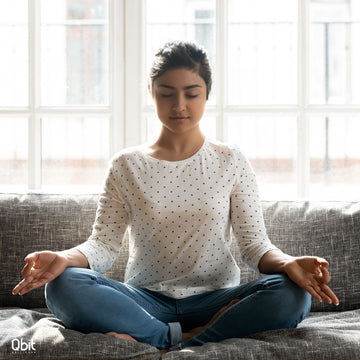You take 23,040 breaths a day. Use your breath to boost your brain health and calm you.
“Just breathe.” You’ve probably seen this mantra on throw pillows, yoga studio walls, or heard it from renowned mental health experts like Thich Nhat Hanh, Dan Brule, and even Oprah.
But what are the real mental and physical benefits of deep, healthy breathing? And how can you begin incorporating the best breathing exercises to relieve tension?
Take a deep breath as we explore the fascinating medical research behind one of the most overlooked yet vital bodily functions—breathing.
Breathwork 101: The Scientific Benefits of Deep Breathing
The average adult breathes 23,040 times each day, often without even noticing. Most people go through life unaware of their breath, even though it’s happening constantly. Deep breathing—also known as abdominal breathing, paced respiration, diaphragmatic breathing, or simply “belly breathing”—is a way to become more conscious of this vital process. It’s a practice that deliberately alters your breathing patterns to bring about well-documented benefits for your body, mind, and spirit.
Dan Brule, a pioneer of breathwork in the West, once said, “Breath is the link between mind and body. Conscious breathing heightens awareness.” During stressful or overwhelming situations, your breath often becomes rapid and shallow, triggering the body’s fight-or-flight response. However, by slowing and deepening your breath, you activate the parasympathetic nervous system, calming your mind and body.
The effects are surprisingly quick. According to Michigan State University, cortisol levels—the hormone associated with stress—can start to drop after just ten deep, conscious breaths. To truly unlock the power of breathwork, there are specific techniques designed to maximize these benefits.

How to Deep Breathe: The Dos and Don’ts of Breathwork
Before diving into specific breathing techniques, it’s important to follow these general guidelines for effective breathwork:
Dos:
- Choose the right time: Practice when you’re not in a rush, so you can relax and focus.
- Find a peaceful environment: Do your breathwork in a quiet, distraction-free space (not a noisy kitchen or busy living room).
- Practice daily: Aim to incorporate breathwork into your daily routine for several minutes at a time.
- Be fully engaged: Stay mindful and connected to your body and breath during the practice.
Don’ts:
- Don’t be passive: Avoid going through the motions. Engage both your mind and body.
- Don’t treat it as a chore: Approach breathwork as an opportunity to connect with yourself, not just another task to check off your list.
- Don’t wait for free time: Make breathwork a priority by scheduling dedicated time in your day.
Consider creating a special ritual or space for your breathwork practice. A cozy corner in your bedroom with soft cushions and candles can help set the mood for relaxation and allow you to settle into deep breathing more quickly.

The three best breathing exercises for releasing tension
1: Breath Focus: The Best Breathing Exercise for Relaxation
The breath focus technique combines deep breathing with mental concentration, helping you break free from the constant inner dialogue that often fuels anxiety. It’s an effective way to ground yourself and regain control, especially during times of chaos or overwhelm.
Instructions:
- Choose a calming word to focus on during the exercise, such as “Om,” “peace,” or “safe.”
- Find a comfortable seat, either on a soft cushion or on your bed.
- Relax your shoulders by raising them to your ears and then gently letting them fall naturally.
- Place one hand on your chest and the other on your stomach.
- Inhale deeply through your nose for two seconds, focusing on expanding your stomach while keeping your chest still.
- Notice the sensations of your breath: the tickling in your nostrils, the feeling of your abdomen rising, or how your clothes move with your breath.
- Mentally repeat your chosen word to yourself if your thoughts start to drift away from your breath.
- Exhale gently for two seconds, fully expelling the air from your lungs and stomach.
- Pause for a moment before repeating the process.
- Repeat for 10 breaths or until you feel a sense of calm and your worries subside.
This practice helps to quiet your mind and brings your awareness fully into the present moment, allowing you to relax both mentally and physically.
2: Lion’s Breath: The Best Breathing Exercise to Energize Your Brain
Lion’s breath, or simhasana, is a type of yogic breathing (pranayama) known for its loud, energetic, and full-lung technique. This invigorating breathwork is often used by singers to stimulate their lungs and vocal cords before a performance. By promoting a strong oxygen exchange, lion’s breath helps clear mental fog, boost energy, and overcome mental fatigue.
The powerful exhale and vocalization can also help release self-limiting beliefs, boost confidence, and clear away negative emotions like guilt or shame.
Instructions:
- Sit comfortably on a cushion or bed.
- Raise your shoulders up to your ears, then relax and let them fall naturally.
- Lean forward slightly, placing your hands on your knees for support.
- Inhale deeply through your nose, filling both your stomach and chest with air.
- Open your mouth wide, stretch your chin toward the floor, and stick out your tongue.
- Exhale forcefully, making a loud “ha” sound as you expel the air.
- Return to regular breathing for 60 seconds.
- Repeat the process 5 to 10 times.
- After finishing, calm your nervous system by using the breath focus technique.
Lion’s breath is an excellent tool to refresh your mind, clear mental clutter, and tap into a renewed sense of energy and confidence.

3: Humming Bee Breath (Bhramari): The Best Breathing Exercise to Clear Negative Emotions
Negative emotions like anger and frustration can have a significant impact on your brain health and overall well-being. The humming bee breath (bhramari) helps release those emotions through the vocal humming and deep vibrations it creates, while also promoting oxygen flow to your cardiovascular system and brain.
Instructions:
- Sit comfortably on a cushion or bed.
- Raise your shoulders up to your ears, then relax them and let them fall naturally.
- Close your eyes and imagine a wave of relaxation sweeping over you.
- Mentally focus on relaxing each part of your body, from head to toe.
- Place your index and middle fingers on the tragus cartilage (the small flap partially covering your ear canal).
- Inhale deeply through your nose.
- Exhale slowly through your nose with your mouth closed, humming as you exhale until all air is expelled.
- Pause briefly, then repeat the process for three to four rounds.
- Once done, calm your nervous system using the breath focus technique.
Deep breathing exercises help deliver more oxygen and nutrients to your brain and other major organs.












